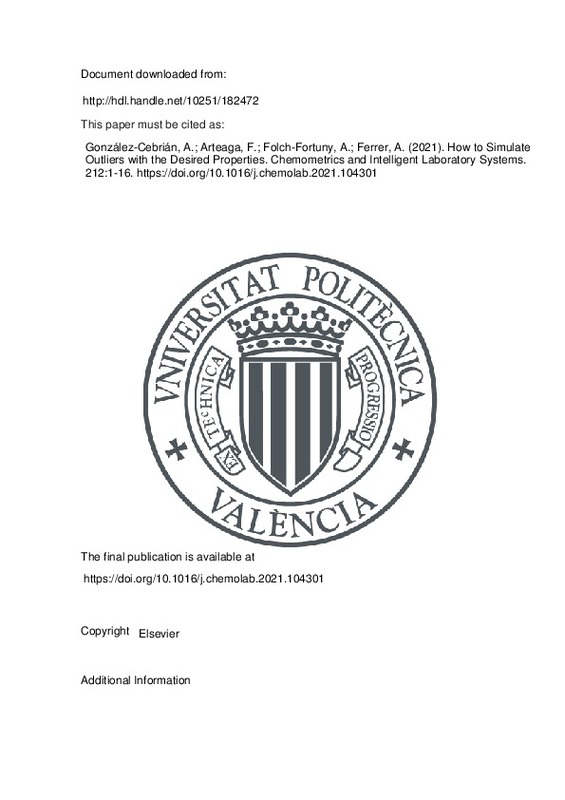JavaScript is disabled for your browser. Some features of this site may not work without it.
Buscar en RiuNet
Listar
Mi cuenta
Estadísticas
Ayuda RiuNet
Admin. UPV
How to Simulate Outliers with the Desired Properties
Mostrar el registro sencillo del ítem
Ficheros en el ítem
| dc.contributor.author | González-Cebrián, A.
|
es_ES |
| dc.contributor.author | Arteaga, Francisco
|
es_ES |
| dc.contributor.author | Folch-Fortuny, Abel
|
es_ES |
| dc.contributor.author | Ferrer, Alberto
|
es_ES |
| dc.date.accessioned | 2022-05-10T18:06:04Z | |
| dc.date.available | 2022-05-10T18:06:04Z | |
| dc.date.issued | 2021-05-15 | es_ES |
| dc.identifier.issn | 0169-7439 | es_ES |
| dc.identifier.uri | http://hdl.handle.net/10251/182472 | |
| dc.description.abstract | [EN] Deviating multivariate observations are used typically to test the performance of outlier detection methods. Yet, the generation of outlying cases itself usually appears as a secondary methodological step in methods comparison. In the literature, outliers are defined using certain distribution parameters which differ from those of the clean or reference data. However, these parameters change among authors, leading to a lack of a standard and measurable definition of the characteristics simulated outliers. This makes the comparison between methods hard and its results dependent on the procedure followed to simulate the data. In order to set a standard procedure, a framework to simulate outliers is defined here. Since it is based on certain specifications for both the Squared Prediction Error (SPE) and Hotelling's T2 statistics from a Principal Component Analysis (PCA) model, tuning them becomes a simple and efficient task. This procedure has been implemented in a set of Matlab functions. | es_ES |
| dc.description.sponsorship | Financial support was granted by the Research and Development Support Programme PAID-01-17 of the UPV and also by the Spanish Ministry of Economy and Competitiveness under the project DPI2017-82896-C2-1-R. | es_ES |
| dc.language | Inglés | es_ES |
| dc.publisher | Elsevier | es_ES |
| dc.relation.ispartof | Chemometrics and Intelligent Laboratory Systems | es_ES |
| dc.rights | Reconocimiento - No comercial - Sin obra derivada (by-nc-nd) | es_ES |
| dc.subject | Outliers | es_ES |
| dc.subject | Squared prediction error | es_ES |
| dc.subject | Hotelling's T^2 | es_ES |
| dc.subject | Simulation | es_ES |
| dc.subject | PCA | es_ES |
| dc.subject | Matlab | es_ES |
| dc.subject.classification | ESTADISTICA E INVESTIGACION OPERATIVA | es_ES |
| dc.title | How to Simulate Outliers with the Desired Properties | es_ES |
| dc.type | Artículo | es_ES |
| dc.identifier.doi | 10.1016/j.chemolab.2021.104301 | es_ES |
| dc.relation.projectID | info:eu-repo/grantAgreement/AEI/Plan Estatal de Investigación Científica y Técnica y de Innovación 2013-2016/DPI2017-82896-C2-1-R/ES/DISEÑO, CARACTERIZACION Y AJUSTE OPTIMO DE BIOCIRCUITOS SINTETICOS PARA BIOPRODUCCION CON CONTROL DE CARGA METABOLICA/ | es_ES |
| dc.relation.projectID | info:eu-repo/grantAgreement/UPV//PAID-01-17//Contratos Pre-Doctorales UPV 2017- Subprograma 1/ | es_ES |
| dc.rights.accessRights | Abierto | es_ES |
| dc.contributor.affiliation | Universitat Politècnica de València. Departamento de Estadística e Investigación Operativa Aplicadas y Calidad - Departament d'Estadística i Investigació Operativa Aplicades i Qualitat | es_ES |
| dc.description.bibliographicCitation | González-Cebrián, A.; Arteaga, F.; Folch-Fortuny, A.; Ferrer, A. (2021). How to Simulate Outliers with the Desired Properties. Chemometrics and Intelligent Laboratory Systems. 212:1-16. https://doi.org/10.1016/j.chemolab.2021.104301 | es_ES |
| dc.description.accrualMethod | S | es_ES |
| dc.relation.publisherversion | https://doi.org/10.1016/j.chemolab.2021.104301 | es_ES |
| dc.description.upvformatpinicio | 1 | es_ES |
| dc.description.upvformatpfin | 16 | es_ES |
| dc.type.version | info:eu-repo/semantics/publishedVersion | es_ES |
| dc.description.volume | 212 | es_ES |
| dc.relation.pasarela | S\432230 | es_ES |
| dc.contributor.funder | AGENCIA ESTATAL DE INVESTIGACION | es_ES |
| dc.contributor.funder | Universitat Politècnica de València | es_ES |







![[Cerrado]](/themes/UPV/images/candado.png)

